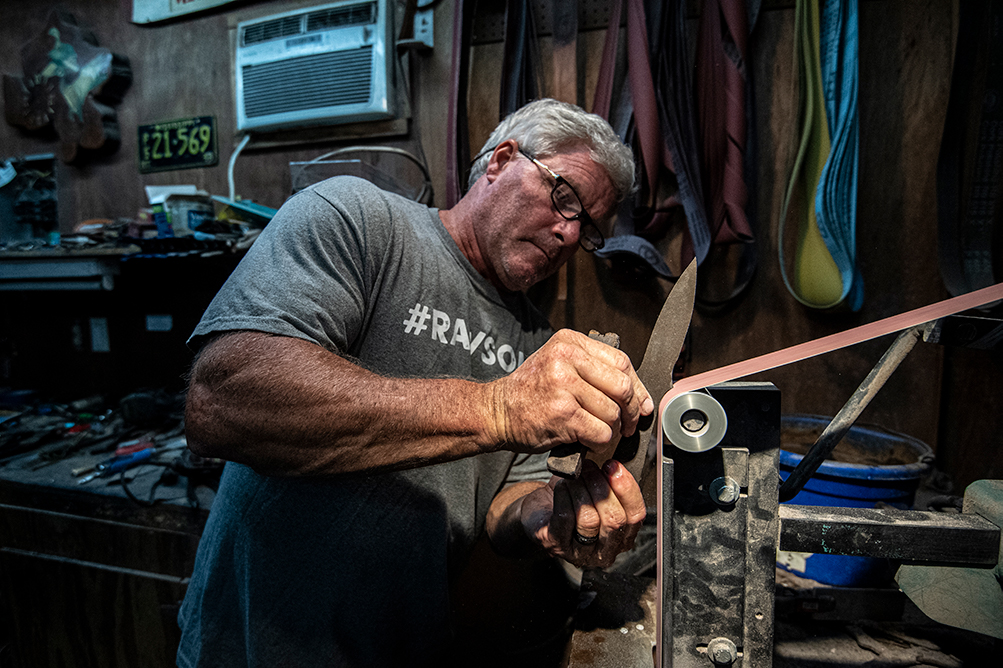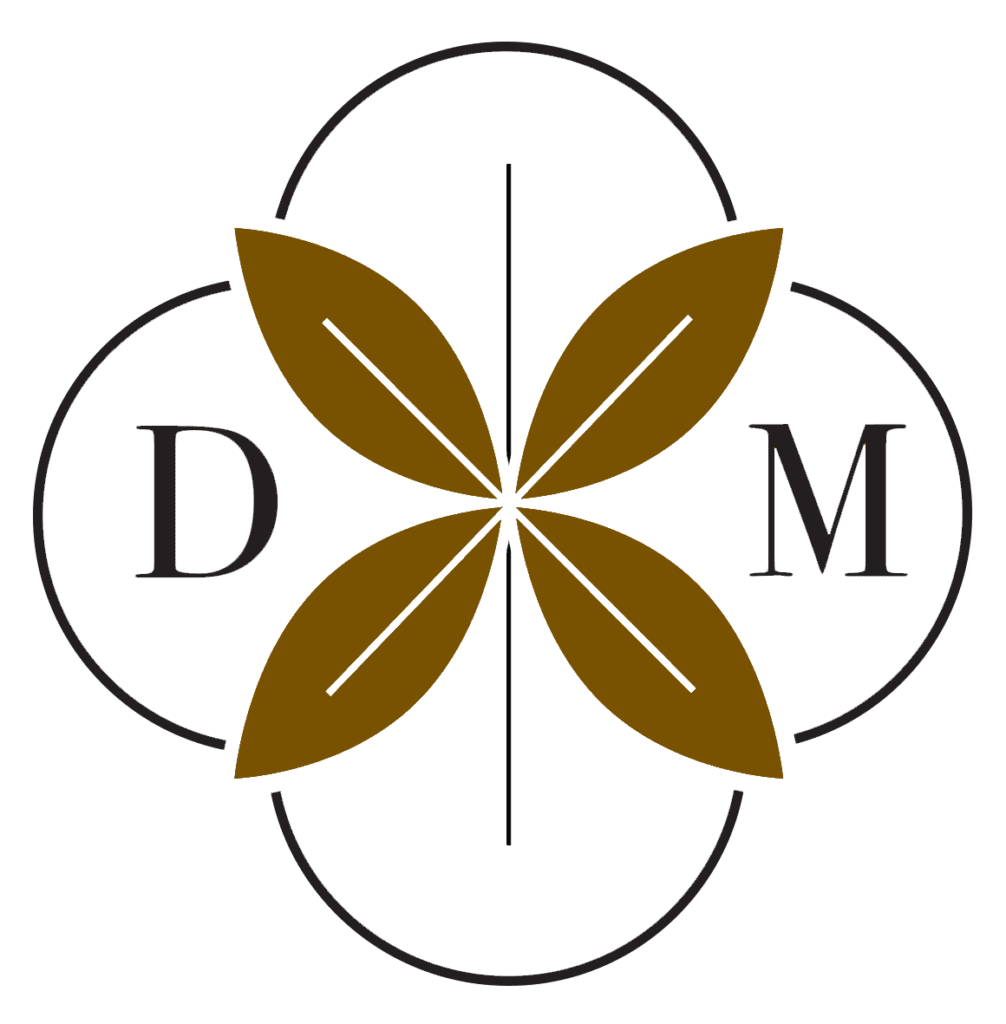by KATIE TIMS • Photography by LOGAN KIRKLAND
Uniquely beautiful, Spence Helms’ custom knives are made to hold an edge

A fine line separates art form from function, and that’s precisely where Spence Helms hones his craft. With twenty-four years of bladesmithing to his credit, this Mississippian transformed a passing fancy into an all-consuming passion that demands time, extraordinary skill and a whole lot of patience.
From hunters in the Delta to fishermen on the Gulf to cowboys in California and at least one football aficionado in Texas, Helms Knives have gone nationwide. No cookie cutters here! That’s because each Helms knife is handmade and designed for function, longevity, and just a touch of pretty.
The Tack Room Workshop
Spence Helms is an electrical lineman on weekdays, but he’s a knife maker on evenings on the weekends. He and his wife, LeeAnn, along with their teenage daughter, Blake, live in Ackerman. The family shares a passion for Quarter Horses, and this is where—oddly enough—Spence’s knife making began.
“I made some spurs and bits for my wife, and one day I just decided to build a knife,” he explains. “I didn’t have the equipment; I just made do with whatever I had.”
It wasn’t much—an ancient belt grinder and a slew of various tools was about it. But it was enough to get the job done.
“I was so proud,” Spence says. “I showed it to my wife and told her, ‘I will never sell this knife! No money can buy this knife!’ We joke about that because now I say, ‘Nobody would want to buy that knife!’ “

He built a knife, but Spence rested on no laurels. “I didn’t want to just build something that would cut. I wanted to take it to another level,” he says.
It was 1996 and the internet was just starting, so there were no digital knife-making tutorials or how-to videos on YouTube. Word of mouth was about it. During a casual conversation Spence learned about an expert knife maker in Starkville. “Winston” was his last name.
“I didn’t know his first name, but I got a Starkville phone book and I called everybody with that last name,” Spence recalls. “On the fourth try I got this guy and he told me, ‘I think you’re looking for my brother, David Winston.’ “
Spence made the call and sure enough, he was the right man.
“David invited me over, and I took the little stuff I’d made and showed it to him. He said, ‘Boy, that looks good!’ I was so proud when he said that—but I think he was really just being nice,” Spence says with a laugh.
Under David’s tutelage, Spence improved his skills and gradually acquired advanced equipment and tools. For several years, he regularly made the twenty-plus mile drive to Starkville to work alongside his mentor.
“David really took me in and helped me,” Spence acknowledges. “He saw that I had an interest to keep getting better and better. Knife making is a challenge and it’s rewarding. It’s just in me.”
Today, Spence makes his knives at home. The family’s barn is now half-horse (stalls and tack room), half-metal workshop. It’s here that Spence keeps his tools, houses his machines, and perfects his craft—one knife at a time.

is heat-treated, so it’s important the blade has that perfect “fit and finish” before it is tempered at 1,850 degrees. When it comes out of the
oven, the knife is blacked and must go through another lengthy sanding process to reach the finish that shines like new silver.
Metallurgy 101
When we think of “steel,” we’re thinking of carbon steel—the alloy of iron with a low percentage of carbon. Basic carbon steel worked great for medieval era swords. But it’s not as popular for knives these days, mostly because it rusts easily and tends to be brittle.
Modern bladesmiths typically use one of two other kinds of steel: ultra high carbon steel or high carbon stainless steel. Both have their positives and negatives. Ultra high carbon steel has more carbon (at least 0.5 %), which makes the metal harder. The harder the steel, the easier it is to attain a super fine, super sharp edge. Of course, the higher the carbon content, the more susceptible the steel is to rust and the harder it is to sharpen.
So chromium is added to the mix. It transforms high carbon steel into stainless steel. The higher the chromium percentage, the better the rust resistance and ease of sharpening. The downside: the more “stainless” the steel becomes, the faster its edges dull. (Think of disposable razor blades.)
“You have to have some rust to hold an edge,” Spence says. “It’s a trade-off. If it’s easy to sharpen, it’s easy to get dull.”

Most knife makers opt for steels that combine several alloys, creating the ideal steel for whatever the cutting job demands. These steels typically fall somewhere between ultra high carbon and high carbon, and each has its own unique properties.
Spence says there’s a give and take between ultra high carbon and stainless and how each applies to the owner’s desire for edge retention, toughness, ease of sharpening, and corrosion resistance (rust). “These steels are just like shoes, everyone has his favorite—I like this, you like that, some guy’s heard a lot about that one. There’s a tradeoff for every knife.”
Forging Perfection
There’s a special protocol for each of Spence’s handcrafted knives. He talks personally with each customer, making notes on all the particulars: purpose, style, color, climate, special requests and, of course, budget. He encourages people to peruse the photos on his Instagram page (helms_custom_knives) for ideas.
The process always begins with matching the blade with the right kind of steel. His favorite is CPM154, a quality high-carbon stainless steel that several established knife manufacturers—such as Kershaw—use for their premium blades.
“Some might think of using pre-formulated steel as cheating, but I don’t,” Spence says. “It’s like making biscuits—they have a recipe. They pour everything in and come out with something that is always high quality. You know exactly what you’re getting.”

patterns or design their own unique patterns.
Basically, it’s the perfect mixture for most of Spence’s customers. In his opinion, CPM154 comes closest to being the best of all worlds (edge retention, toughness, ease of sharpening, and corrosion resistance). It’s also affordable.
Spence takes the customer’s chosen template and traces it onto a steel bar. Customers may choose from the dozens of templates hanging on the wall in his workshop, or they can design something brand new.
“If you can dream it and I can cut it out of steel, it can be a knife,” Spence says.
First, he makes a rough cutout using an old belt grinder and 60-grit paper, and then uses a more advanced grinder to carve out the curves, edges and corners. At this point, the knife reaches its final shape.
Next, Spence drills the handle holes and then mounts the knife on a powerful magnetic plate. He uses a surface grinder to make sure the knife is perfectly flat. This is an important step because air can collect in gaps during the tempering process, which compromises the integrity of the metal.
Now the hardest part begins.

Spence takes a Sharpie pen and traces in the line where the blade angles down toward the edge. This is called a “bevel.”
“That line is always going to be in the middle of the knife,” he says. “Grinding this part is difficult and you’ve got to pay attention. The bevel angle has to be perfectly matched on both sides of the blade, otherwise it will be lopsided.”
He acknowledges that he’s had more than a few lopsided results.
“It took a lot of practice and sometimes it could be pretty frustrating,” Spence says. “It would be three o’clock in the morning and I’d still be in my work room. I’d grind up anything that would sit still long enough.”
These days, Spence eyeballs the horizontal bevel line to confidently glide even, precise grinds along both sides. He uses various grits in this process—starting with 60 then going to 120, 220, and 320. Everything is perfectly symmetrical.
“You look down the center and make sure you’re staying steady and even on both sides,” Spence emphasized. “The finer grit takes out the previous grit. You have to be careful to not get the blade too thin.”
At this point, Spence is not making a sharp edge—that comes later. Right now, it’s all about the art. He hand-sands the knife until all the scratches are removed and the metal shines like new silver.
“I call this the ‘fit and finish,’ “ Spence says. “I guess you can have a correctly made ugly knife—they all cut. But finishing a knife takes it to the next level and makes it pretty. I want my knives to be pretty.”
Scratches and imperfections are almost impossible to remove once the steel is heat-treated, so it’s important to have perfectly smooth metal at this step in the process. Once the polish is satisfactory, Spence coats the knife in baby powder and wraps it in a stainless steel sheet that resembles aluminum foil. This sheet protects the knife until the oven heats the metal to the point where tempering begins. (Eventually the protective sheet burns off.)
The knife’s steel is hardened after baking for one hour at 1,850 degrees. It comes out with a black matte coating, so Spence hand sands the knife with 400-grit paper until the shiny silver finish returns. Next he grinds out the secondary bevel, or the sharp cutting edge.
Then he attaches the handle. This is also custom ordered. It can be metal, but it’s more likely to be bone, wood or a composite material. Other adornments are added upon request.
Another Helms Knife is finished. Spence admits that his knives are not the easiest to sharpen, but he insists that his edges are strong enough to skin seven or eight deer before needing to be sharpened. After all, a durable sharp edge is what a knife is all about. That’s why Spence sends a handwritten note and a Band-Aid with each of his knives.
“No one’s complained about that yet,” he concluded with a laugh.
A custom-made leather sheath is the final touch. Spence bought a sewing machine and taught himself how to stitch and tool the leather. Customers choose the individual details and whether or not they desire stamping. There are multiple styles from which to choose, although a simple sheath with a belt loop is the most popular.
“Each knife has its own sheath made for it,” Spence says. “They kind of have to go hand-in-hand, and it would be tough to outsource each one and have it fit. That’s why I started doing it myself. Besides, I like that each of my knives is totally custom—from start to finish.”
Spence Helms can be contacted at 662.285.7007 or via Instagram at helms_custom_knives.




1 thought on “Form & Function”
Spence Helms can be reached at 662.285.7007 or via Instagram at helms_custom_knives_
.